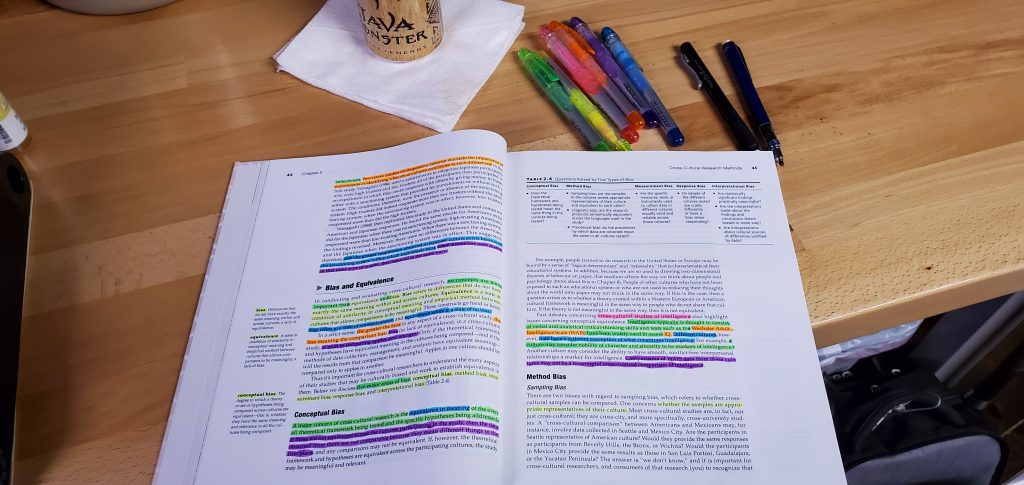Blog 10
I was kind of nervous to refer back to my Blog 1 “self” to now (she was very optimistic), but I think I’ve achieved the course objectives quite well. I think through it all, I’ve examined the influence of culture on psychology, scrutinized culture’s impact on our lives, advanced an understanding of culturally-different people, developed critical thinking skills to culture’s influence on (literally) everything, and made a ton of connections both with other classes and my own personal life (and the lives of those around me).
My attitudes on Cultural Psychology actually aren’t that different from Blog 1; I was actually kind of surprised my Blog 1-self had such a firm grasp on what the course would be about. I’ll say the concepts weren’t difficult to grasp, but associating those concepts with the correctly-named terms got somewhat difficult a time or two. I had a few of those “I know what it is, but I don’t know what it’s called” moments (especially with terms that were very similar to one another).
If I retook this class, one thing I would do differently is managing my workload a lot better. It may just be an issue of how my mind works, but I would have all these big, interconnected ideas for assignments… I’d try to work it all out, connecting all these concepts together, and it was too much. I wrote way too much for my assignments, and because of it, I would run out of time and not finish everything I started. I have a tough time reigning in my expanding thoughts, and I can inadvertently do much more than is “required” for an assignment. It’s a recipe for failure.
One way I’ve grown academically over the last few months is really recognizing where my faults are. That interview question that asks, “what would you consider your biggest weakness?” And the cheesy, non-answer of “taking on too much”? Yeah, that actually is my biggest weakness, and it’s a glaring one that can blockade my future successes if I don’t recognize when I’m doing it and control it. Friends of mine have told me multiple times that I do that, but I scoffed and thought, “how could wanting to give 200% for everything be a bad thing?” Well, it is when you can’t feasibly meet the goals you set, and the whole project is useless because there are time constraints within reality. …Having that realization finally sink in (after years) is possibly one of the most significant ways I’ve grown my entire college “career.”
I’m not sure if it would be regarded as a “skill” perse, but one thing I’ve certainly gained from this course is “perspective.” Every module and every chapter of this class has given me a new way to look at everything: from the words I use, to how I look at gender, to my cognitive processing of stimuli, even how I view myself and identity. Not having a set “framework” to work from expands my perspective outward, which is something I think will consistently be used in professional life.

Blog 9
The top three things I’ve learned so far in this course is how much language contributes to our perception and worldview, how much gender ideologies have changed (and stayed the same), and how much we can learn about “the self” through our society and culture.
When it comes to language/communication, I recall after reading the very first chapter of the semester and writing the very first assignment, putting my thoughts in about how I thought language would affect us. It was both surprising and reassuring to get this far and realize that my mind was in the right place all those weeks ago. I was hoping to read about language this last chapter and see that my assumption on our English-language obsession with “age” (due to English conflating the “self” with our age versus e.g., Spanish saying “I have ___ years”) would be proven correct, but it wasn’t. I didn’t consider “body language,” or nonverbal communication, as a thing back then though, so I still enjoyed learning about it.
When it comes to culture and gender, it was interesting to compare the “gender stereotypes in occupation” with my grandmother; separated by a generation, many were the same, but there were some notable differences for sure. For example, my general practitioner is a woman, so she was the first person I thought of for “doctor” and was, therefore, gendered in that occupation in my mind. It goes to show how representation does matter; I mentioned the same in my blog referring to growing up watching women doctors in Star Trek and Xena Warrior Princess as a “fighter warrior.”
When it comes to “the self,” I’m always looking for self-awareness and how we can still learn more about ourselves; so the blog where we got to do the quiz was both engaging and self-reflective. I honestly think “the self” has played a part in every single area because when learning new material, the question is “where does my culture fit in to this?” and “where do I fit within my culture within this concept?” and it becomes an “inception” of self – culture – world and it cycles back and around.
When it comes to how this course connects to other courses, I was astonished going through this semester because I felt as if almost every module in this class could reflect back on philosophy, philosophical theory, or a well-known philosopher’s perspective in some way and it’s how I would remember to differentiate certain theories. For example, I thought of “terror management theory” as Camus’ enemy. When I thought of the universality of autonomy, I actually thought of determinism from a philosophical perspective and how it connected to philosophy.
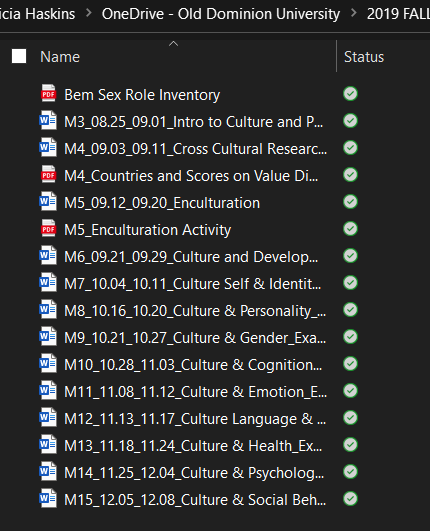
Blog 8
After reading the article Emotion Perception Across Cultures, I realized that some of the misinterpretations of emotion between myself and others made more sense.
Because the article focused predominately on Japanese cultural-emotional interpretation, it seems fitting to analyze the interactions between myself and my friend’s wife, Sayuri, who grew up in Japan but now lives in the United States. One thing I’ve noticed about Sayuri is that she does smile a lot, even when I can tell she’s not particularly happy or is worried about something. This makes me think (based on the article) that I’m subconsciously paying more attention to her eyes when I can tell she’s not happy, even if she’s smiling.
On the other hand, Sayuri will ask me if there’s anything wrong with me because she claims I seem “off,” even when there’s genuinely nothing wrong or if it’s something that I wouldn’t necessarily consider “wrong” (e.g., like only being a little “tired” after a late-night studying). The article makes me believe now that she was paying attention to my mouth to look for social cues. One thing of note in regards to that is that I don’t necessarily smile “at all times” in social interactions.
I didn’t really have expectations when I first met Sayuri; she seemed tired reasonably often, but I knew that was because my friend just opened his first store location; Sayuri had her day job, and she would come in to help with the store after she was done. Other than that, I think our behaviors were more similar than different. We were both “friendly” and “warm.” I did occasionally feel bad about our interactions because I had not become attuned to her annunciations yet. Sayuri had to repeat phrases for me to understand them because, being a native-Japanese speaker, her consonant-stresses and pronunciation of -Ls and -Rs were difficult to discern. However, I learned a little Japanese to understand where the grammatical and pronunciation clashes were to decipher them better and to understand how vowels and consonants operated in Japanese. It was a positive learning experience because it helped me understand exactly why English was so difficult for a native-Japanese speaker (we combine a lot of vowels and consonants that simply do not exist in the Japanese language).
I do think the “concept of universality” and “cultural display rules” could explain some of my interactions with Sayuri. I think the fact that we both interpret a smile as “happy” (or rather, positively) is indicative of the concept of universality. Further, I think both our understandings and some misunderstandings may have come from cultural display rules and overcompensating for one culture or the other. For example, I can tell when she’s not really happy by her eyes (if, as an American, I’m supposed to base emotional display off of the mouth) and I can also misinterpret her eyes for one emotion, when it’s really another (e.g., “sad” for “worry”). The same can be said, in reverse, for how Sayuri interprets my emotions based on cultural display rules.
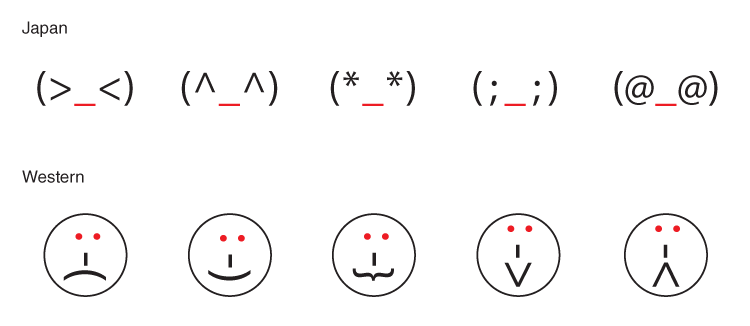
I chose this image because it highlights the differences in cultural expression of emotion via emoticons. Indicated in red are the parts of emoticons that stay the same; in Japan, the “mouth” portion of an emoticon is constant, while the “eyes” remain constant in the other emoticons (referred to as “Western”).
Retrieved from: https://blog.btrax.com/culture-design/
Blog 7
This may be contrarian or revealing of my age a bit, but I feel that fairy tales (and stories in general) have taken a significant step back in some regards when it comes to reflecting a shared set of cultural norms and values, and a step forward in others. The article, “Tale As Old As Time,” argues that Disney’s portrayal of Beauty and the Beast “has always been progressive on issues of gender representation” (the 2017 version specifically; para. 2); and cites segments of the film as evidence. I would argue that Disney’s portrayal of the tale is “safe” and “corporate-approved” rather than “progressive” by any sense of the word; the film reflects, more than any notion of progressivism, how capitalism shapes media and representation.
The article discusses how Belle, instead of her father, is an inventor. Mechanical ingenuity may be a trait typically associated with males, but it’s telling how they chose to present her mechanical prowess. Belle is not designing, drawing out schematics, or testing metals for the next evolution of transportation, improving carriage design, architecture, or infrastructure projects; she is creating a washing machine. Although it is no small feat, the theme of domesticity and “the home” cannot be escaped. Two steps forward, 1 ½ steps back. Disney’s safe route of gender representation ensures that a vast middle ground will be content; Belle is an inventor, so she’s a capable woman, but she’s really the most proficient while working in a domestic capacity. “Progressive” it is not, but it may reflect enough of the “safe middle ground” to keep most content with the arrangement (and accumulate sales).
I do think that the main characters in fairy tales and stories can model, have an impact, and leave an impression on young audiences. Because of this, egalitarian roles are essential to not putting anyone in a metaphorically-restrictive box. Despite my personal qualms with the representation in Beauty and the Beast, I still think some of the modeling is somewhat helpful. For example, because Belle is an inventor, that does offer a visual model that younger audiences can see and interpret. Both young girls and young boys will see that “builder” and “creator” are roles that women/females can embody. Beyond that, Disney ultimately fails at modeling egalitarian roles on young audiences (at least in this instance) because they bring unnecessary attention to it instead of merely showing it. By the outward hostility displayed in the film against women and girls reading, it could be interpreted by younger audiences as something abnormal (even if it’s chastised). By Belle’s father stating that Belle is “ahead of her time” (para. 2), it reinforces the notion that Belle is also abnormal; how she operates and thinks is contrary to the rest of the community.
After reading these most recent chapters and going through the modules (particularly gender & culture), it made me evaluate the media and gender representation that I grew up with and how it may have influenced me. I hate to be that person (i.e., “back in my day”), but I do see how gender, sex, and sexuality representation was handled better in some instances in the ’90s, at least with the media I consumed at the time. One of my favorite shows growing up was Xena: Warrior Princess; the way Xena was portrayed made me believe that it was normal that there were female warriors and fighters. I was young, so it’s possible that I don’t remember everything with 100% accuracy and clarity, but I don’t recall it being “unusual” that Xena was an honorable warrior on a journey of redemption, she just was.

Retrieved from: https://www.elreynetwork.com/shows/classics/xena/5
Comparing that reality to the article (“Tale As Old As Time”) where a young girl is chastised for reading in Beauty and the Beast, and it gets to the heart of my issue with Disney’s version of “progressive representation”: a perfectly normal activity is displayed as abnormal, just to have an opportunity to spurn the people rebuking the normal activity. Disney creates barriers that aren’t there to appear “progressive.” Xena just was. She existed in a fantasy show depicting a time of ancient Greece, her feats were portrayed as her being a formidable warrior, and her as a redeemable person. Xena: Warrior Princess also represented non-heterosexuality in ways that they don’t usually do today. I was born in 1992, and Xena aired from the mid-‘90s to ~2000 (so I was still pretty young), but I still knew that Xena was bisexual. She traveled with her female companion/interest, Gabrielle, but also had male interests, like Hercules. Compare that to the article where LeFou’s sexuality was represented almost 100% by a public statement before the film ever came out. When the film did come out, the “exclusively gay moment” is represented by dancing, which isn’t really “new” by the standards of a century’s worth of film media. In one example (i.e., Xena), representation just simply is, and therefore, is processed as usual and the norm. In the other, “representation” is so on-the-nose, it’s almost as if Disney is outwardly saying it’s not normal, “so mentally prepare.”
It could be argued that Xena is rated TV-PG or TV-14 (depending on the episode), it could be aimed at an “older audience,” or it may not be fair to compare with Disney on representation (despite the two-decade gap). To that, I would say Star Trek: Deep Space Nine, which aired in the nineties as well, also did gender, sex, and sexuality representation substantially better than Disney, and Star Trek has always been a kid-friendly, general-audience show (excluding the most recent addition, Discovery); DS9 tackled issues related to gender, sex, and sexuality in unique ways and in multiple instances. I recall watching DS9 as a kid and really mulling over some of the conflicts presented; one involved one of my favorite characters, Jadzia Dax.
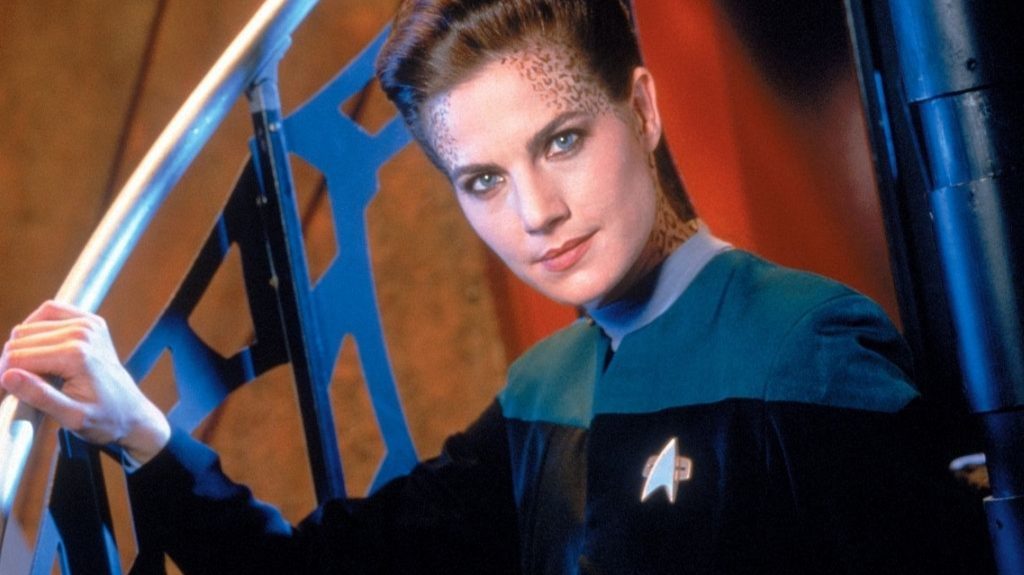
Retrieved from: https://www.syfy.com/syfywire/wtf-moments-jadzia-daxs-death-on-deep-space-nine
Dax was a Trill, an alien race who functions as two beings in one: a symbiote, who is represented by the last name (i.e., Dax) and the host body, who shares conscious awareness with the symbiote (i.e., Jadzia). The body can die, and the symbiote carries a piece of the conscious awareness of that body on to another host body. In one episode, Jadzia Dax came into contact with a woman whom Dax had fallen in love with while bound to the host body, Curzon, a male Trill host. Trying to “continue” love interests from a deceased host is strictly forbidden in Trill culture because it deprives the new host body of a fulfilling life. Despite this, Dax pursues the interest from when Dax was bound to Curzon, and it endangers Jadzia’s and Dax’s bonding. These are comparatively deep themes for a general audience/kid-friendly network television show, and it brings into question what gender, sex, and sexuality are in our own cultures and beyond that, issues of identity and self-concept.
I’m certainly not insinuating that the ’90s had perfect gender, sex, and sexuality representation (extremely far from it); I’m only saying that Disney is not “progressive.” Disney’s insistence that it is progressive on these issues while putting forth content that is aggressively middle-of-the-road is disingenuous and merely another corporate calculation. It no longer makes sense from a profit-driven computation to exclude groups of people when the financial loss of doing so is greater than the potential gain from not. Disney isn’t posing thought-provoking questions or challenging norms, it’s meeting a tame/moderate perspective.
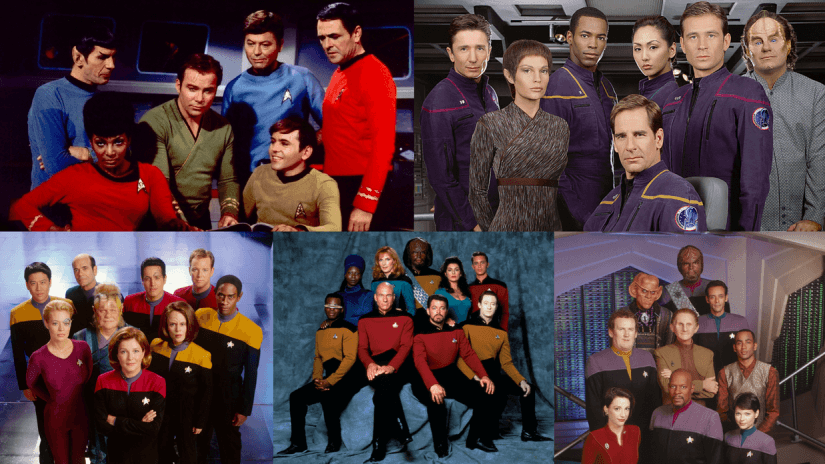
Retrieved from: https://www.denofgeek.com/us/tv/star-trek/258233/star-trek-50-best-episodes 
Retrieved from: https://nerdist.com/article/everything-star-trek-discovery-got-right-and-wrong-in-season-1/
I chose these images to illustrate inclusiveness in media over the course of about fifty years. It’s no secret to “Trekkies” that the creator of Star Trek (i.e., Gene Roddenberry) very deliberately diversified the cast against the “norms” of the time (mid-1960s) for Star Trek: The Original Series (TOS) and Star Trek: The Next Generation (TNG; late 1980s-early 1990s) for inclusivity. That tradition has continued with every iteration (except Enterprise; the most unpopular series) until the latest/current series, Discovery. Inclusiveness was expanded with each series: Deep Space Nine (DS9) featured the first Black Captain (Sisko), Voyager featured the first female Captain (Janeway), and the ongoing Discovery features a female Malaysian Captain (Georgiou), a Black female Commander (Burnham), and a Chief Engineer who is gay (Paul), married to the head Medical Officer of the Discovery (Hugh, who is gay and Black). Although Star Trek is not perfect in every story-telling trope it’s employed in it’s 50+ years, it’s a series that’s always strived to be progressive in the time period it aired.
Blog 6
Reading the article on Self-Determination Theory (SDT) was an interesting exercise in self-analysis because I got to reflect on myself and how I satisfy my need for autonomy, competence, and relatedness while in academia. The sobering reality is that I completely deny myself those needs, mostly out of fear and an attempt to exert self-control.
When I’m in a semester and taking courses, I absolutely love everything about it. I love learning new things and proving my prowess via essays and big projects as the semester continues. Being in college, and taking classes is an intrinsic motivation with (most of the time), intrinsic regulation.
However, when I am in a college semester, I also deny myself entertainment, like television-watching, except during the time that I’m eating dinner. This is because I feel as if I know myself, and I know the severity of the ADHD I have, so I do not allow myself to get sidetracked. For example, my favorite hobby of all time is playing videogames and I can play for hours if I really get into a game. So, during a college semester, I will unplug and put away my PlayStation 4 and it doesn’t get played again until my last final exam for my last class is taken. In a way, my loss of autonomy is a combination of regulatory styles depending on the semester and the classes. At the beginning of a semester and when I’m taking classes I love, my motivations are intrinsic and the perceived loci of causality is internal. When I’m in a class that’s too easy or I’m not engaged with, my motivations are then extrinsic, but I still internally regulate it. The ADHD, in and of itself, is an external loci of causality. In essence, I have a constant external locus of causality that alters my perceptions of what I want to do, so I exert autonomy to control it and stay on track. In philosophical terms, working within the confines of “determinism.”
The same is with competence and relatedness. I exert all of my efforts into my school work, so it’s aided me with competence. Relatedness suffers due to my autonomous choices because I do not go out to engage with others during a semester. Literally my entire focus is on my school work and to a much lesser extent, my day job. Work, School, Home is the typical cycle during a semester. It is by my own choice to work within the confines of my limitations.
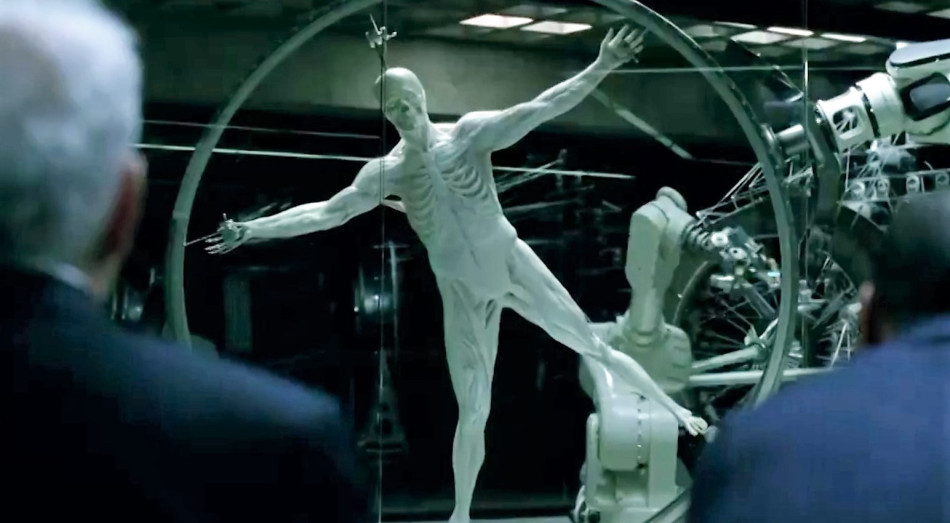
I chose this image because it’s representative of one of my favorite shows and a form of “determinism”
Retrieved from: https://lucasmland.com/2018/08/20/westworld-loops-and-the-enneagram/
Blog 5
- I am a Student
- I am Honest
- I am an Atheist
- I am Progressive
- I am an Aunt
- I am Determined
- I am Inquisitive
- I am Imaginative
- I am Introverted
- I am ADHD
The statements I think are associated with the dimension of “independent construal of self”: 2, 4, 6, 7, 8, 9, 10
The statements I think are associated with the dimension of “interdependent construal of self”: 1, 3, 5
Considering I had more answers to the “independent construal of self” than the “interdependent construal of self,” I think it’s accurate to say that I would consider myself as more independent. Although I have a more independent construal of self, I also have no qualms about the interconnectedness of others and human beings as a whole within our society.
“You can take a horse to water, but you can’t make it drink.”
“We can give advice to others, but they have to decide for themselves what to do.”
Independent Construal of Self
“Two heads are better than one.”
“Working together would be better than working alone.”
Interdependent Construal of Self
I thought it would be easier to think of proverbs that reflected the “independent self” versus the “interdependent self,” but honestly it was more evenly-matched. The possible reasons I can think of for this tendency are (1) growing up in a military family (e.g., the military is a group/unit) and (2) the interdependent-like proverbs are commonplace in some forms of media that emphasize “working together” (e.g., Start Trek).
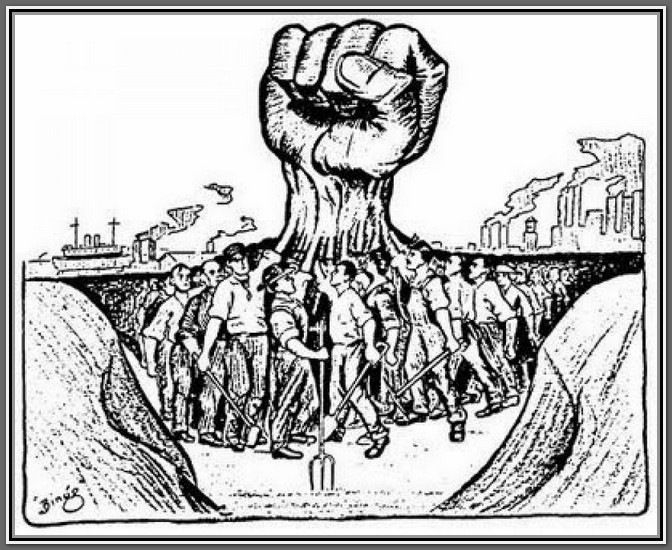
Retrieved from: https://adrdaily.com/important-forces-make-workers-join-union/
Blog 4
After going through and reviewing my results from “Exam 1,” and then looking for the correct answers to the items I answered incorrectly, I learned that I mentally shuffled a lot of very similar terms when taking the test. I did take notes as I read through the chapters, and I also highlighted vital terms/phrases in my textbook. However, one significant fault in my plan to ace the test was that I did not go over the review sheet; nor did I space the review sheet out in the week prior to the test to cement the information necessary to pass with an A. It is abundantly clear that my own “Exam 1 strategy” was woefully insufficient.
Knowing what I know now, I will have to overhaul my strategy for future tests. First, I will use the review sheet as recommended; it’s there to help, and I should have taken advantage of that opportunity for the first test. Second, I will have to commit substantially more time to differentiate key terms and phrases. There were questions that I was absolutely sure I had gotten right while taking the test, only to see I had gotten them wrong after the self-review. It didn’t fully sink in how similar so many of the terms were until after I took the test and reviewed it. Some words were a synonym off; some were merely a letter off. Either way, I had mentally shuffled enough definitions to be disappointed with my performance. Finally, I will be a lot more cognizant of the scientists and researchers that have worked to establish all of these cultural psychology theories. It was apparent, after my self-review, that I had not adequately linked the theories/terms to the individuals that did the experimental work to establish them. I surmise that if I simply follow the already-established winning formula, I’ll be more sufficiently prepared for future exams.
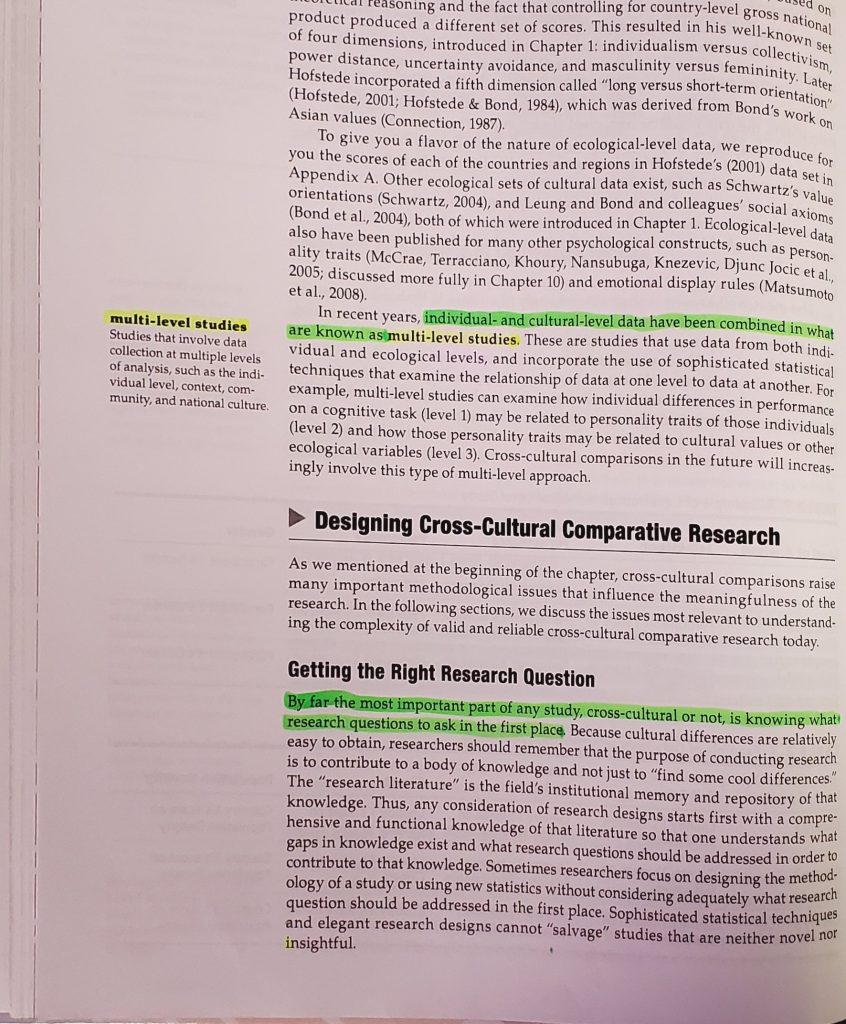
Old Highlighting Strategy 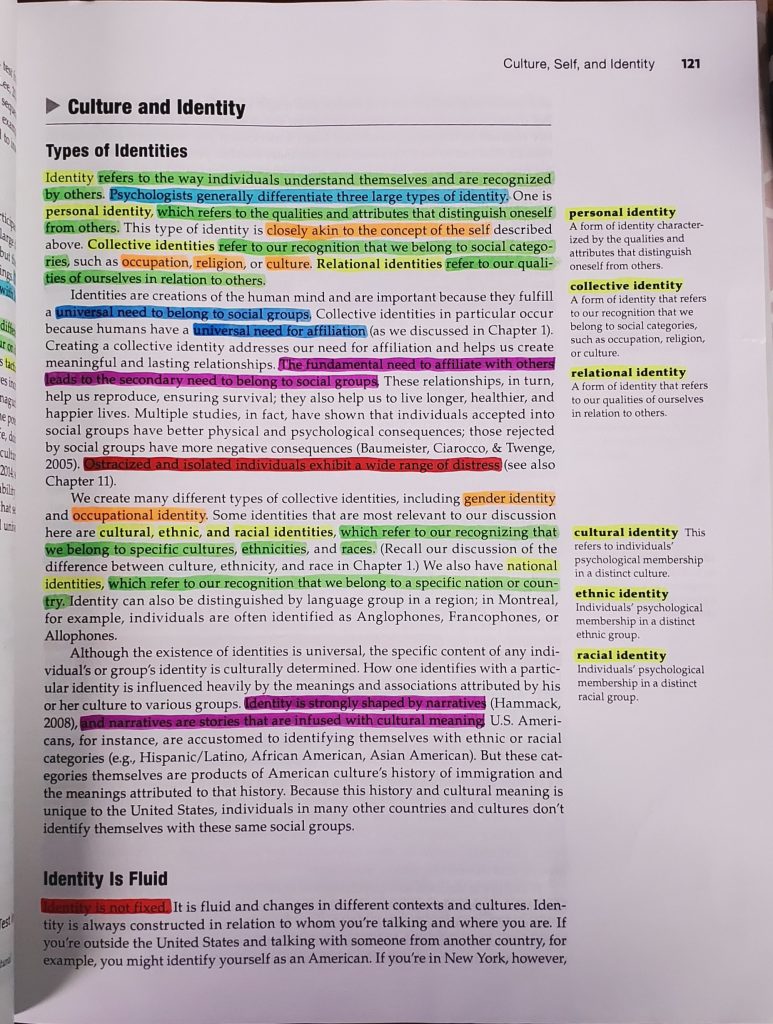
Newer Highlighting Strategy
I chose these images to show one of the changes I’ve made in note-taking to review information a little better. To go from only keeping track of basic “key terms” to establishing a color system to help me codify the information in a more comprehensive way.
Blog 3
According to the NEO Five-Factor Inventory Profile (Costa & McCrae, n.d.), my personality measurement of openness scored the highest out of all of my other measured dimensions at 41. A measure of “41” is categorized as “very high” under the “female” inventory profile (Costa & McCrae, n.d.). I think my personality is highly consistent with the measure of “openness” because its focus is on the “new,” “abstract,” “curious” (Cherry, 2019), and Costa and McCrae (n.d.) summarize having “broad interests” within this dimension. Although I enjoy satisfying my curiosity about something deemed “important” or “relevant,” it can be a hindrance when my “openness” keeps me engaged with unrelated peculiarities. For example, the other night, I found a bovine species called “Belgian blue” and was curious as to why it looked so muscular. I spent well over an hour learning about a genetic mutation the species can have where the regulation of muscle growth isn’t there, and further time pondering the feasibility of such a mutation to treat human musculoskeletal disorders. Instead, I should have gone to sleep at a reasonable time, considering I have very little knowledge of genetics in the first place.
My personality measurement of conscientiousness scored at “28,” which is somewhat “low” under the “female” inventory profile (Costa & McCrae, n.d.). I think my personality is consistent with the measure of this dimension; however, I do not wish it to be. Conscientiousness centers on being organized, structured, and not procrastinating (Cherry, 2019), all things that I struggle with but wish I did not. Costa and McCrae (n.d.) elaborate even further with my occasional, unintentional carelessness and inability to make and follow through with plans. An example of my consistency with this is apparent from my previous model: it was illogical to lose sleep to satiate a random curiosity. Low conscientiousness is something I’ve struggled with through life, and I actively attempt to correct that deficiency every day with note-taking, timers, and calendar-keeping and make a substantial effort to stay on track.
My personality measure of agreeableness scored at “28,” which is within the “low-average” range of the “female” inventory profile (Costa & McCrae, n.d.). I think this rating is more dubious for my personality measurement; somewhat accurate, but the “high” versus “low” rating appears less comparable. For example, a “high” grade characterizes traits such as “altruism,” “empathy,” and “prosocial behaviors” (Cherry, 2019) while a “low” score insinuates that one doesn’t even have an interest in other individuals, insults others, and is capable of manipulating them (Cherry, 2019). I don’t think that’s a decent one-to-one comparison, but I suppose I would somewhat fall in the middle if the “high” score indicators are accurate. For example, I do have a great deal of empathy for others and engage in altruism, but I also have little patience if I feel those traits are being taken advantage of: I am very direct with an individual if that occurs. If the score were more in “average,” it would make sense by Costa and McCrae’s (n.d.) description of being “generally warm,” but can be “stubborn and competitive” as well.
My personality measure of extraversion scored the lowest out of all of my other measured dimensions at “10,” which is within the “very low” range of the “female” inventory profile (Costa & McCrae, n.d.). I speculate this measure is extremely accurate when a low score accounts for “disliking small talk” (Cherry, 2019) and generally being more “introverted, reserved … [and] prefer[ring] to be alone” (Costa & McCrae, n.d.). I do enjoy being around my friends and family, but it is as if no matter who it is I am physically spending time with, I have to spend at least some time each day completely alone. This trait is excessively evident on the days I work: I manage one of my friend’s store locations and no matter how slow or busy a day is, I am always cranky ~5-6 hours into the workday because I don’t want to interact with anyone else. I am still polite in my interactions with people, but I have absolutely no desire to engage in small talk; it inevitably feels as if my “social battery” is drained by then.
Finally, my personality measure of neuroticism scored at “25,” which is within the “average” range of the “female” inventory profile (Costa & McCrae, n.d.). According to Costa and McCrae (n.d.), an “average” score of neuroticism indicates that one can usually deal with stress and anxiety, but there are occasional spikes in emotion. Cherry (2019) claims a low score is indicative of “emotional resiliency” and “stability,” while a high score points to “emotional instability.” For me, I believe this measure is mainly dependent on the time of day, so it makes sense that my grade is in the range of “average.” To elaborate, I don’t think most people know how symptoms of ADHD can manifest in adults and/or women; but in me, the hyperactive/impulsive component can display with rumination (e.g., the “racing thoughts”), especially in the morning or evening (i.e., pre- or post-medication). My fully-functional mind can usually reason through any irritation and, most of the time, not even get upset or irritated in the first place. But it’s a different story when you can feel your mind, your ability to focus and reason, slip from you in the evening; or when you have to get up twice as early in the morning to get ready or get anywhere on time. That’s when neuroticism tends to fluctuate higher, while ~10 hours of the rest of the day, I would place myself in a much calmer, relaxed range of neuroticism.
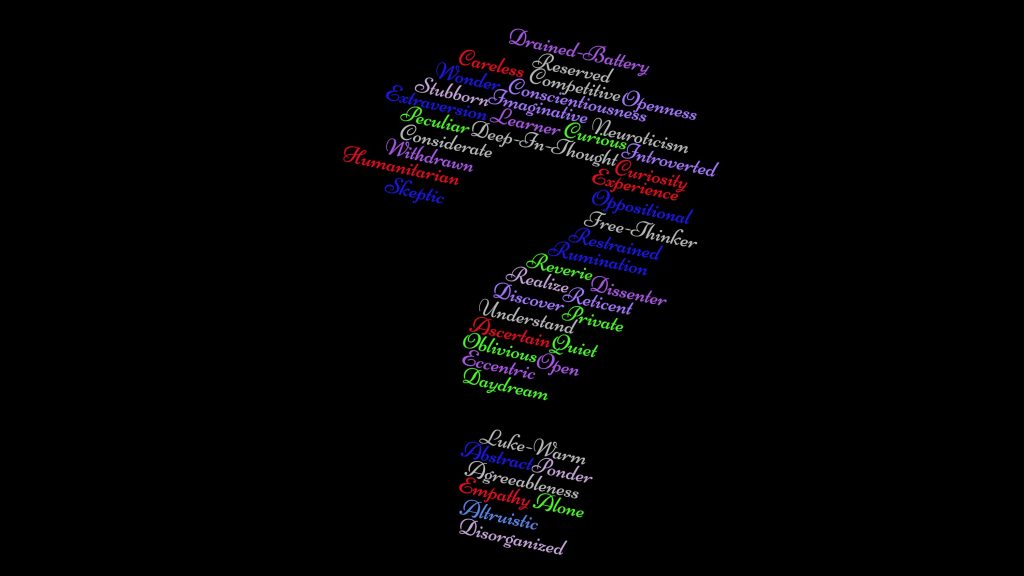
I made this word cloud with the words I thought best matched my personality based on the Blog assignment and the personality dimensions reviewed in the assignment. I used a question mark because of my higher score in “openness.”
Made on: https://www.wordclouds.com/
Cherry, K. (2019, August 26). The big five personality traits: 5 major factors of personality. Verywell Mind. Retrieved from https://www.verywellmind.com/the-big-five-personality-dimensions-2795422
Costa, P. T., Jr., & McCrae, R. R. (n.d.). Your NEO Summary. [PDF]. Retrieved from https://www.blackboard.odu.edu/
Matsumoto, D. & Juang, L. (2018). Culture and Psychology (6th ed.). Boston, MA: Cengage Learning.
Blog 2
When I reflect on my “personal values,” some of them are extremely important to me and relevant to my career pursuits, but also somewhat adversarial to my familial values and overall cultural values. For example, I believe I have a more “collectivist” approach within the “individualism versus collectivism” dimension (Matsumoto & Juang, 2018). This value is relevant to my career pursuits because if you’re working in psychological research, for example, it’s essential to interact and communicate with other researchers efficiently. It’s also important to put the research, data collection, and data analysis above your own interests. For example, if you’ve worked for months or years on a hypothesis, it could be tempting to include outliers in your data analyses that would help “prove” your theory; but the truth should always outweigh any individual desires.
From “Schwartz’s universal cultural values” (Matsumoto & Juang, 2018), I see where I may differ from familial and cultural values the most (albeit, not exclusively) in “embeddedness,” “mastery,” “intellectual autonomy,” and “egalitarianism” (Matsumoto & Juang, 2018). I speculate that being significantly low in “embeddedness” would be helpful for career pursuits because it fosters dissent and speculation: you cannot research “new ideas” without first looking at established ideas and either tweaking them or disagreeing with them. I consider that being high in “mastery” would be beneficial because being successful in graduate studies would require a thorough examination of material; not merely copy-and-paste memorization or repetition. I think that being high in “intellectual autonomy” would be valuable because it encourages thinking in critical ways. Finally, I imagine that being high in “egalitarianism” would be advantageous because it promotes the “welfare of others” (Matsumoto & Juang, 2018) over one’s own desires and wishes (e.g., as referenced above with “individualism versus collectivism”).
When I think about various experiences in my life that have made being a student at Old Dominion possible, I consider how I am extraordinarily fortunate to have one person that didn’t give up on me: my grandmother. About four years ago, I was utterly down-and-out; I lost my driver’s license from my third car accident within a single year, I lost my job because I couldn’t get to work without a car, and I only had a home because of my grandmother. She believed I was astute, but couldn’t grasp “life” and that there was something more wrong. She helped me discover that something was very wrong: that I had lived, up until that point, with moderately-severe undiagnosed attention-deficit/hyperactivity disorder. Not only did the car accidents suddenly make sense, but everything I struggled with in my everyday life. From paying bills on time, even when I had the money, to driving, to functioning well in various jobs, to accurate time-management and organization, etc. Most of all, it explained why I loved to learn but didn’t do well in school (especially the first time I attempted college after high school). Through my grandmother helping me through the absolute lowest point in my life, I was able to start treatment and get back to what I always loved, but [this time] functionally: learning.
I went back to college because it was something I always wanted to do, but before my diagnosis, I believed I just wasn’t “smart enough.” After my diagnosis and after beginning medication treatment, I realized that a lot of people, including myself, were wrong. I just couldn’t “fit it all together.” When people ask how I didn’t know or realize how wrong things were, I bring up colorblindness (i.e., color deficiency). There’s no real way to know that you are colorblind unless you take a test or someone tells you you are. You believe the world you see, the world your eyes project as a series of images to your brain to decode and process, is accurate: why wouldn’t you? However, you may be under the assumption that you’re “bad at colors”; to see how others don’t have a problem with something you believe should be “simple,” but you continue to struggle. When you have lived with moderately-severe ADHD your entire childhood, adolescence, and young adult life, there’s no way to merely “know” that the world you see, and the stimuli you process, is slowed and disorganized. I compare my off-medication functionality and processing to the equivalent of two to two-and-a-half beers; not an exaggeration in the slightest: pre-diagnosis, I had been required, on one occasion, to conduct a roadside sobriety test completely sober. The struggle doesn’t go away with medication alone either; I still work with a therapist to set systems in place to function well and stay organized in my school-work-life balance.
As for a support structure, my grandmother was the only one who believed I could go back to college and succeed. My immediate family and friends had gotten used to me losing interest or focus on things and just moving on to something else. I was, and am, extremely fortunate to have my grandmother push me to figure out what was wrong while helping me back on my feet. If I didn’t have someone to tell me they thought something wasn’t right, possess the financial means to help figure it out, and be willing to help, I wouldn’t be here today.
Matsumoto, D. & Juang, L. (2018). Culture and Psychology (6th ed.). Boston, MA: Cengage Learning.
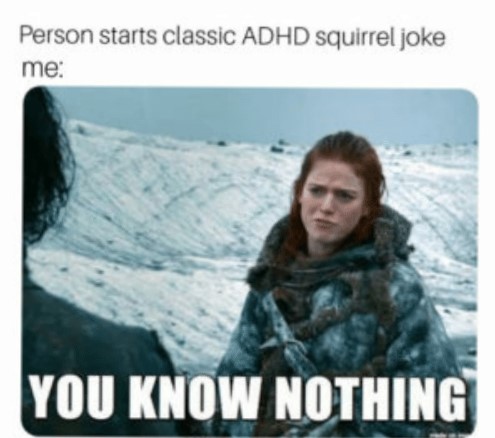
I chose this image because, as a joke within a joke, it says a lot about how society, and cultural perspectives within said society, can be misinformed about certain disorders. Cultural values can influence the “weight” placed on disorders that may not be immediately “visible” and the chances of individuals getting help for them.
Retrieved from: https://me.me/i/person-starts-classic-adhd-squirrel-joke-me-you-know-nothing-93e7b743b9db40c0937b5350aa9a4538
Blog 1
After reviewing the “course objectives” outlined in the Course Syllabus, they all seemed to boil down to one central concept: cognitive empathy. The ability to know how one sees and interprets the world is through restricted tunnel vision; that others have their own varying degrees of tunnel vision; and that it is possible to alter one’s tunnel vision to coincide with another’s field of view. The skills I’ll learn in this course will help me in the future by honing and directing my natural skepticism in a manner that is beneficial. I’ve often had internal questions in previous semesters concerning cultural influence while conducting research or just lost in my thoughts. A few semesters ago, I did a research project on ADHD. While looking for peer-reviewed articles, I noticed that all of my sources from the United States had much larger samples of male participants in the studies, as opposed to a larger sample of female participants or a controlled-random sample to even out the sex demographics.
In contrast, I also found translated, peer-reviewed articles from Hong Kong, and the samples were held constant for sex demographics. I recall wondering if our cultural stereotypes of ADHD in the United States were skewing the samples, or if there was some other explanation for why that pattern emerged in all the peer-reviewed articles I found. I expect that by the end of this class, I will be able to understand why (or at least how I can find out) instead of merely “noticing” when I catch things like that.
I’m hoping to gain a deeper understanding of how individuals from other cultures perceive the world, as well as myself. For example, just yesterday I was driving home from getting coffee, deep in thought, and listening to a playlist called “Viva Latino” on Spotify; I’m not fluent in Spanish, but I can understand enough to comprehend a lot of the “top hits.” I happened to be thinking about my age during that drive. How I want to continue to graduate school, but also how “behind” I feel, in life in general, as I’ll be twenty-seven when I graduate from ODU. That’s when it hit me as I was listening to that playlist on Spotify.
It’s interesting how in the English language we discern what we own from ourselves, and we codify what we are by the word “am.” I can say, “I am short,” or “I am tall,” and (at my age) it’s something that is not likely to change until old age; but it still varies depending on one’s age. On the other hand, it always makes sense to say “I have brown eyes,” as opposed to “I am brown eyes.” Even though our eyes are a permanent fixture for us, we still place ownership over them in English instead of making them a part of our essence, of who we are (i.e., am) because we are more than eyes.
We do not do the same for our age. I say, “I am 27.” And our age becomes a part of us, of our essence, of who we are, what we are.
This class (already) made me realize this is how we communicate meaning in our English language. Spanish communicates age not by saying our age is who we are, but by saying, “I have 27 years.” “Tengo veintisiete anos.” I like the way Spanish interprets the concept a lot better because it removes it from something that we are to something temporary that we have.
I intend to continue implementing critical thinking throughout the course to succeed. To try to link concepts to things I’ve already thought about or new examples I haven’t considered about from the textbook. Finally, “terms” can be difficult for me personally, so note-taking is necessary for me to succeed.
